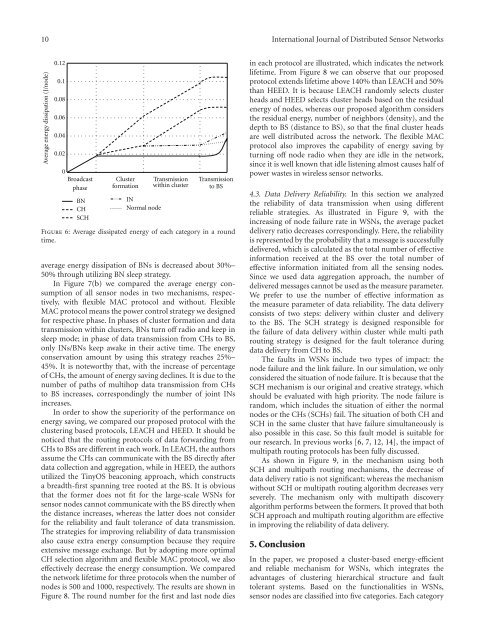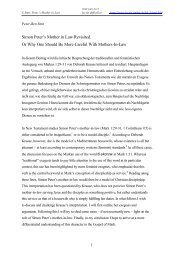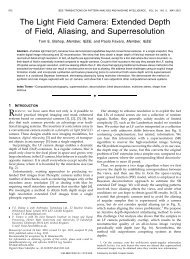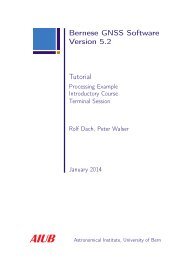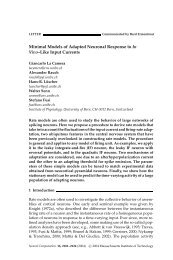Deploying Real-Life WSN Applications: Challenges ... - IAM - CDS
Deploying Real-Life WSN Applications: Challenges ... - IAM - CDS
Deploying Real-Life WSN Applications: Challenges ... - IAM - CDS
You also want an ePaper? Increase the reach of your titles
YUMPU automatically turns print PDFs into web optimized ePapers that Google loves.
10 International Journal of Distributed Sensor Networks<br />
Average energy dissipation (J/node)<br />
0.12<br />
0.1<br />
0.08<br />
0.06<br />
0.04<br />
0.02<br />
0<br />
Broadcast<br />
phase<br />
BN<br />
CH<br />
SCH<br />
Cluster<br />
formation<br />
IN<br />
Normal node<br />
Transmission<br />
within cluster<br />
Transmission<br />
to BS<br />
Figure 6: Average dissipated energy of each category in a round<br />
time.<br />
average energy dissipation of BNs is decreased about 30%–<br />
50% through utilizing BN sleep strategy.<br />
In Figure 7(b) we compared the average energy consumption<br />
of all sensor nodes in two mechanisms, respectively,<br />
with flexible MAC protocol and without. Flexible<br />
MAC protocol means the power control strategy we designed<br />
for respective phase. In phases of cluster formation and data<br />
transmission within clusters, BNs turn off radioandkeepin<br />
sleep mode; in phase of data transmission from CHs to BS,<br />
only INs/BNs keep awake in their active time. The energy<br />
conservation amount by using this strategy reaches 25%–<br />
45%. It is noteworthy that, with the increase of percentage<br />
of CHs, the amount of energy saving declines. It is due to the<br />
number of paths of multihop data transmission from CHs<br />
to BS increases, correspondingly the number of joint INs<br />
increases.<br />
In order to show the superiority of the performance on<br />
energy saving, we compared our proposed protocol with the<br />
clustering based protocols, LEACH and HEED. It should be<br />
noticed that the routing protocols of data forwarding from<br />
CHs to BSs are different in each work. In LEACH, the authors<br />
assume the CHs can communicate with the BS directly after<br />
data collection and aggregation, while in HEED, the authors<br />
utilized the TinyOS beaconing approach, which constructs<br />
a breadth-first spanning tree rooted at the BS. It is obvious<br />
that the former does not fit for the large-scale <strong>WSN</strong>s for<br />
sensor nodes cannot communicate with the BS directly when<br />
the distance increases, whereas the latter does not consider<br />
for the reliability and fault tolerance of data transmission.<br />
The strategies for improving reliability of data transmission<br />
also cause extra energy consumption because they require<br />
extensive message exchange. But by adopting more optimal<br />
CH selection algorithm and flexible MAC protocol, we also<br />
effectively decrease the energy consumption. We compared<br />
the network lifetime for three protocols when the number of<br />
nodes is 500 and 1000, respectively. The results are shown in<br />
Figure 8. The round number for the first and last node dies<br />
in each protocol are illustrated, which indicates the network<br />
lifetime. From Figure 8 we can observe that our proposed<br />
protocol extends lifetime above 140% than LEACH and 50%<br />
than HEED. It is because LEACH randomly selects cluster<br />
heads and HEED selects cluster heads based on the residual<br />
energy of nodes, whereas our proposed algorithm considers<br />
the residual energy, number of neighbors (density), and the<br />
depth to BS (distance to BS), so that the final cluster heads<br />
are well distributed across the network. The flexible MAC<br />
protocol also improves the capability of energy saving by<br />
turning off node radio when they are idle in the network,<br />
since it is well known that idle listening almost causes half of<br />
power wastes in wireless sensor networks.<br />
4.3. Data Delivery Reliability. In this section we analyzed<br />
the reliability of data transmission when using different<br />
reliable strategies. As illustrated in Figure 9, with the<br />
increasing of node failure rate in <strong>WSN</strong>s, the average packet<br />
delivery ratio decreases correspondingly. Here, the reliability<br />
is represented by the probability that a message is successfully<br />
delivered, which is calculated as the total number of effective<br />
information received at the BS over the total number of<br />
effective information initiated from all the sensing nodes.<br />
Since we used data aggregation approach, the number of<br />
delivered messages cannot be used as the measure parameter.<br />
We prefer to use the number of effective information as<br />
the measure parameter of data reliability. The data delivery<br />
consists of two steps: delivery within cluster and delivery<br />
to the BS. The SCH strategy is designed responsible for<br />
the failure of data delivery within cluster while multi path<br />
routing strategy is designed for the fault tolerance during<br />
data delivery from CH to BS.<br />
The faults in <strong>WSN</strong>s include two types of impact: the<br />
node failure and the link failure. In our simulation, we only<br />
considered the situation of node failure. It is because that the<br />
SCH mechanism is our original and creative strategy, which<br />
should be evaluated with high priority. The node failure is<br />
random, which includes the situation of either the normal<br />
nodes or the CHs (SCHs) fail. The situation of both CH and<br />
SCH in the same cluster that have failure simultaneously is<br />
also possible in this case. So this fault model is suitable for<br />
our research. In previous works [6, 7, 12, 14], the impact of<br />
multipath routing protocols has been fully discussed.<br />
As shown in Figure 9, in the mechanism using both<br />
SCH and multipath routing mechanisms, the decrease of<br />
data delivery ratio is not significant; whereas the mechanism<br />
without SCH or multipath routing algorithm decreases very<br />
severely. The mechanism only with multipath discovery<br />
algorithm performs between the formers. It proved that both<br />
SCH approach and multipath routing algorithm are effective<br />
in improving the reliability of data delivery.<br />
5. Conclusion<br />
In the paper, we proposed a cluster-based energy-efficient<br />
and reliable mechanism for <strong>WSN</strong>s, which integrates the<br />
advantages of clustering hierarchical structure and fault<br />
tolerant systems. Based on the functionalities in <strong>WSN</strong>s,<br />
sensor nodes are classified into five categories. Each category


